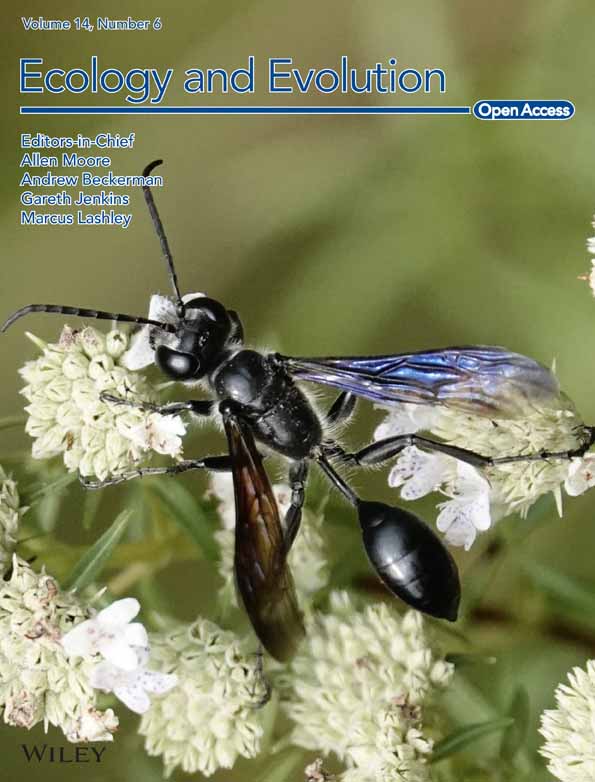Tooth Mg/Ca ratios and Aristotle's lantern morphometrics reflect trophic types in echinoids
Abstract
Several studies have inferred the ecological significance regarding the morphometrics of Aristotle's lantern and the mechanical properties of magnesium in echinoid teeth. This study attempts to combine these aspects, connecting them to the trophic habits of three native and an invasive echinoid in the Eastern Mediterranean Sea. Spatiotemporal data from the central and southern Aegean Sea were obtained, regarding the relative size of lanterns and demi-pyramids of Arbacia lixula, Paracentrotus lividus, Sphaerechinus granularis, and the invasive echinoid Diadema setosum and the Mg/Ca ratios of four zones on the tooth cross-section. Since environmental factors affect the examined factors, data for temperature, salinity, and concentration of chlorophyll-a were included in a principal component analysis. A. lixula and P. lividus presented intraspecific differences in the relative size of the lantern and demi-pyramid, while S. granularis and D. setosum exhibited variation in the elongation index. Differences in the Mg/Ca ratios were observed for all species although in different zones. Temperature appears to be related to all Mg/Ca zones except for the stone part, while the elongation index showed an inverse trend to all other morphometric parameters. The results of the PCA for the four species on the spatiotemporal level exhibited a distinction of individuals with season but not species, except for A. lixula, an omnivore with a carnivorous tendency, which was clearly separated from the herbivorous species. Using hierarchical clustering on the principal components it was evident that the three native species occupy different clusters, but when D. setosum was added, it shared the same cluster with S. granularis. This might infer similar feeding preferences, specifically for coralline algae, which might lead to a swift in the ecological equilibrium in regions, where D. setosum is found, either by affecting habitat type, or by restricting the distribution of S. granularis as was previously observed with Diadema africanum.
1 INTRODUCTION
The feeding ecology of a species influences its population dynamics, affecting key aspects such as resource partitioning, habitat preference, prey selection, and competition and trophic ecology. The feeding behavior of echinoids has long been a subject of interest. Most sea urchins are primarily herbivorous (Johnson & Mann, 1982). They exhibit a variety of feeding habits and behaviors with seasonal and spatial variations in their feeding activity (e.g., De Riddler & Lawrence, 1982).
Plasticity is crucial for an organism not only to survive but also to thrive under changes in food availability (Levitan, 1991). Sea urchins are observed to utilize energy allocation in different organs depending on the availability of resources (Hill & Lawrence, 2003). The relative length of the demi-pyramid to test diameter is an adaptive morphological characteristic which increases when food is scarce (Ebert, 1980; Ebert et al., 2014; Levitan, 1991). However, this is not necessarily a plastic response to food scarcity but might be related to different growth rates due to variation in food availability, as shown by deVries et al. (2019). Hagen (2008) proposed that the enlargement of the lantern is a functional specialization for durophagy. The plasticity of the lantern of Arbacia dufresnii populations with different feeding habits is not dependent on a trophic source but could indicate different trophic tendencies among species (Agnetta et al., 2013; Bonaviri et al., 2011; Epherra et al., 2015). Thus, it is possible that different species exhibit different morphometric profiles depending on their feeding habits, which they might alter either when food is scarce or when they change the source of food intake.
The self-sharpening mechanism of the sea urchin tooth has recently drawn much attention (e.g., Espinosa et al., 2019; Killian et al., 2011; Ma et al., 2009). The tooth cross-section of echinoids presents a variety of shapes, from keeled and grooved to wedge-like and diamond-shaped, which is hypothesized to confer different functional properties (Ziegler et al., 2012). The Mg content of echinoid teeth seems to be related to hardness, however, it is shown to vary with skeletal element, taxonomy, and latitude, while abiotic factors like temperature, salinity, and ambient seawater Mg/Ca ratio and even food source also seem to have a strong influence on the mineralogy of the echinoid skeleton, which would mean that the mechanical properties of the tooth can vary not only among species, but also between intraspecific populations (Kolbuk et al., 2019; Ma et al., 2009; Smith et al., 2016; Varkoulis et al., 2020).
When viewed in cross-section, the mature part of the sea urchin tooth exhibits three different sections, namely, the primary plates, the stone part, and the keel. The primary plates section is composed of layers of plates parallel to each other, while the stone part is constructed by calcareous needles connected to the primary plates. Finally, the major building structures of the keel are called prisms. It has been shown that hardness and Mg content decrease, as the distance from the stone part (the hardest section of the tooth) increases (Markel & Gorny, 1973; Wang et al., 1997). However, a clear relationship between abiotic factors and taxonomy with hardness or mineralogy of specific sections of the tooth has yet to be established.
The recent thermal increase in the Mediterranean Sea has intensified the introduction of invasive tropical species (Bianchi, 2007). The first record of an invasive echinoid in the Mediterranean was that of Diadema setosum, which was reported in 2006 in Kas peninsula and since then its distribution has been extended in the Aegean sea, where established populations have been reported (Vafidis et al., 2021; Yokes & Galil, 2006). A successful invasion can only take place, when the invading species can cope with the new environmental conditions and usually exhibits some adaptive advantage (Smith, 2009). In the case of D. setosum it was previously shown that it presented decreased Mg content in the skeleton compared to its counterparts in the Pacific without compromising the survival rate due to its chemical defense (Voulgaris et al., 2021). However, there is neither evidence regarding the interactions of D. setosum with the native echinoid species of the shallow sublittoral zone, namely Arbacia lixula, Paracentrotus lividus, and Sphaerechinus granularis nor information about its feeding ecology in the Mediterranean.
This study compares the morphometric indices of the Aristotle's lantern and demi-pyramids, while also examining variations in the Mg/Ca ratios of the tooth of four echinoid species with different dietary preferences, to infer whether there is a connection among diet, morphometrics, and mineralogy in echinoids. Subsequently, the trophic role of the invasive echinoid D. setosum in the Eastern Mediterranean Sea is speculated.
2 MATERIALS AND METHODS
2.1 Study area and satellite remote sensing data
This study was carried out at three sites of the Aegean Sea, Eastern Mediterranean, namely at Pagasitikos Gulf (39°18′25.5702″ N, 23°5′53.4222″ E), at the island of Kalymnos, Dodecanese Island complex (36°56′15.5328″ N, 26°59′16.0542″ E), and at the island of Paros, Cyclades Island complex (37°5′30.4686″ N, 25°9′19.6884″ E) (Figure 1). The Aegean Sea is characterized by complicated topography, making it a unique island archipelago, with over 2000 islands, numerous gulfs, embayments, and straits. The gulf of Pagasitikos is located in the central-east Aegean, whereas both the Dodecanese and Cyclades Island complexes are situated in the southern part of the Aegean. The southern basin is distinguished from its central and northern counterparts by substantial different water masses (Zervakis et al., 2000). This is reflected by differences in both abiotic and biotic factors, with the most prominent parameter being temperature (Androulidakis & Krestenitis, 2022). The two island complexes are separated by deep seas. Furthermore, the Dodecanese complex is considered the gateway for Lessepsian species, which tends to alter the biodiversity in the Mediterranean Sea (Azzurro et al., 2011; Pancucci-Papadopoulou et al., 2012). All of the aforementioned features regarding the three studied regions could be summarized in which they belong to different biogeographical modules, each with different evolutionary history, as shown in Kougioumoutzis et al. (2016).
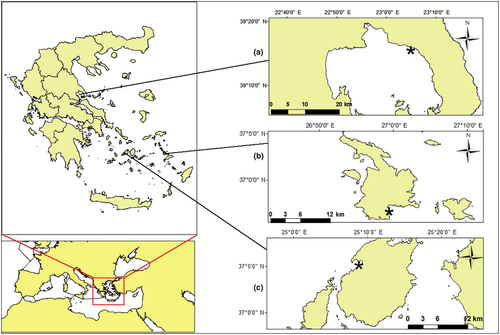
To examine the effect of seasonality, samplings were caried out in December (WinPag) and June (SumPag) of 2020 at Pagasitikos Gulf for the three native species and in the same months at Kalymnos Island (WinDod: December in Kalymnos; SumDod: June in Kalymnos) for D. setosum. Additional samplings were performed in December in the island of Kalymnos for A. lixula, P. lividus, and S. granularis and in June in the island of Paros (SumCyc) for the invasive species, where a newly established population was found, to assess the spatial effect. Sampling sites and periods were chosen taking into account the size and number of individuals for each species (Figure 1).
Data regarding the sea surface temperature, salinity, and concentration of chlorophyl-a were acquired from the NASA EOSDIS Physical Oceanography Distributed Active Archive Center (PO.DAAC) (https://podaac.jpl.nasa.gov/) and Ocean Biology Distributed Active Archive Center (https://oceancolor.gsfc.nasa.gov/). Specifically, temperature was obtained from the Group for High Resolution Sea Surface Temperature (GHRSST) SST (version 1.0) product, salinity from the Soil Moisture Active Passive (SMAP) Project, and chlorophyl-a from the Ocean Biology Processing Group. The GHRSST (K10L4) archived data are produced on an operational basis at the Naval Oceanographic Office (NAVOCEANO) on a global 0.1 degree grid at daily temporal resolution, while SMAP produces data on a global 0.6 degree grid at 8-day intervals. Finally, the data for chlorophyll-a were acquired with a resolution of 4 km grids produced from daily datasets. In order to account for daily variation, monthly data were acquired characterizing the abiotic conditions in each region and season.
2.2 Sample collection and morphometric measurements
Forty adult individuals of the three native species, namely P. lividus, A. lixula, and S. granularis and of the invasive D. setosum were collected at each site and season from the shallow sublittoral zone (1.5–5 m) by SCUBA diving. Previous studies have determined that sea urchins might shift their dietary preferences from juvenile to adult; thus, only adult individuals were collected (González-Durán et al., 2008). Regarding the native species, adult individuals were considered those with test diameter larger than 50 mm, whereas for D. setosum individuals over 70 mm were sampled (Boada et al., 2017; Coppard & Campbell, 2006). Once collected they were transported alive in a cooler in the laboratory for processing.
- Aristotle's Lantern Index (LI) = LD/D,
- Demi-pyramid Length to Test Diameter Ratio (DLD) = LP/D,
- Demi-pyramid Length to Test Height Ratio (DLH) = LP/H.
- Demi-pyramid Elongation Index (DhDl) = DPH/DPL.
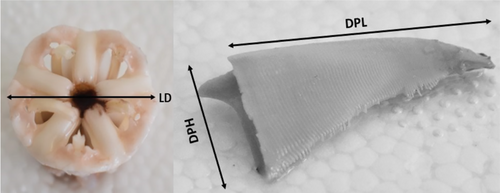
2.3 Energy dispersive spectroscopy analysis (EDS)
To semi-quantify the magnesium/calcium (Mg/Ca) ratio in the teeth, 10 individuals per treatment and species were analyzed using a JEOL JSM 6510 equipped with an Oxford Link ISIS 300 system. The teeth were acquired by carefully dissecting the demi-pyramids. They were subsequently gently rinsed with sodium hypochlorite (5%) followed by fresh water to remove the soft tissue. Further processing consisted of transversally sectioning the teeth with a diamond saw near the tip, where the keel (or the groove for D. setosum) was fully exposed, and grinding and polishing the samples from both sides. The processed samples were then mounted in metal stabs with a carbon-based tape and spatter-coated with 6 nm carbon (Varkoulis et al., 2020). To determine variations in different parts of sea urchin teeth, four zones were established and stratified by both distance and orientation relative to the stone part as suggested by Masic and Weaver (2015), (Figure 3). A minimum of three measurements per zone was taken from an elliptical area of about 200 μm2.
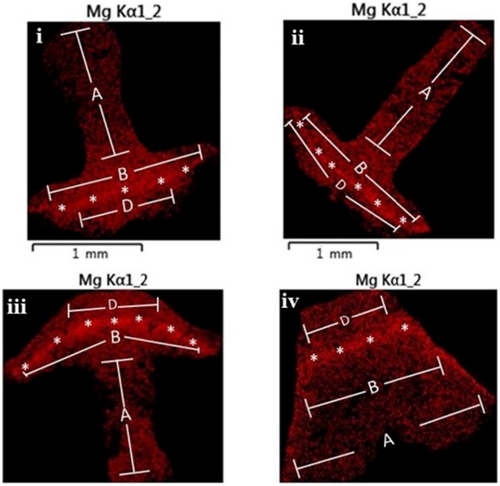
2.4 Statistical analysis
One-way ANOVA was applied to investigate intraspecific spatio-temporal variations both for morphometric indices and Mg/Ca content. Variations among species and zones were also determined by one way ANOVA. Prior to the analyses, data were tested for normality and homogeneity, using the Kolmogorov and Kohran's test, respectively. Post-hoc comparisons were carried out using the Tukey's HSD test, which controls for Type I errors resulting in multiple comparisons. One-way ANOVAs were performed using the software Minitab ver. 19 (Minitab, Inc, 2019).
Additionally, a principal component analysis was conducted for the four morphometric indices and the Mg/Ca ratios of the four zones on the species level, to determine interspecific similarities among the morphometrical and mineralogic profiles. PCA was also employed to examine the combined effect of morphometric indices, Mg/Ca zones, and abiotic factors on each species by treatment. For this purpose, the “FactoMineR”, “factoextra”, and “ggplot2” packages in the R® software (V 4.2.0) were used. Finally, to obtain information about the level of similarity among the species, when the combined effect of morphometrics and chemical composition is taken into account, hierarchical cluster analysis on the principal components (HCPC) was used. Using the “FactoMineR” package, the algorithm of the HCPC method was implemented. Using the Kaiser's criterion, the number of principal components to be used was determined and the HCPC function adopted the Euclidean distance to characterize the distance between observations and the Ward's agglomeration method was used to build the hierarchical tree. To improve the initial partition obtained from hierarchical clustering, K-means clustering was intergraded in the algorithm (Husson et al., 2010). The visualization of the dendrogram was made with the package “dendextent”.
3 RESULTS
3.1 Morphometric indices
On the intraspecific level, two distinct trends were observed, namely either a change in the relative size of the Aristotle's lantern and demi-pyramid length in relation to test diameter, or a change in the demi-pyramid elongation index. P. lividus and A. lixula presented increased values for the lantern index (LI) (p = .003; p < .0005) and the DLD ratio (p < .0005 for both species) in Pagasitikos in winter, compared to individuals from Pagasitikos in summer and from Dodecanese in winter. S. granularis and D. setosum exhibited significant variation regarding the elongation index (DhDl) (p = .036; p = .014) (Figure 4). S. granularis appeared to have wider demi-pyramids (DhDl) in Pagasitikos in winter compared to the same region in summer. D. setosum exhibited wider demi-pyramids during winter in Dodecanese, compared to Cyclades in both seasons. Finally, no change was observed in the relative length of the jaw to the test height for any of the examined echinoids.
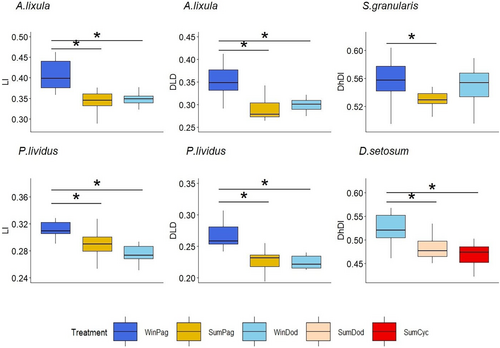
The examination of the interspecific effect exhibited significant differences for all morphometric ratios (Table 1). The lantern index (LI) of A. lixula presented highest values, while P. lividus showed the lowest ones. S. granularis and D. setosum displayed intermediate values. The same pattern was observed for the relative demi-pyramid length to test diameter (DLD). S. granularis exhibited the lowest tooth length to test height (DLH), followed by P. lividus and D. setosum, whereas A. lixula displayed the highest values. Regarding the elongation index (DhDl), A. lixula presented lowest values, whereas S. granularis exhibited the highest ones. P. lividus and D. setosum presented intermediate ratios with no statistical differences when compared with each other (Table 1).
| Morphometric indices | A. lixula | D. setosum | P. lividus | S. granularis | p-value |
|---|---|---|---|---|---|
| LI | 0.37 ± 0.04a | 0.32 ± 0.04b | 0.29 ± 0.03c | 0.34 ± 0.03a,b | <.001 |
| DLD | 0.31 ± 0.04a | 0.27 ± 0.03b | 0.24 ± 0.03c | 0.26 ± 0.02b | <.001 |
| DLH | 0.59 ± 0.07a | 0.49 ± 0.06b | 0.48 ± 0.07b | 0.43 ± 0.07c | <.001 |
| DhDl | 0.44 ± 0.02a | 0.49 ± 0.03b | 0.49 ± 0.04b | 0.54 ± 0.03c | <.001 |
| Mg/Ca Zones | |||||
| A | 0.03 ± 0.01a | 0.04 ± 0.01a | 0.03 ± 0.01a | 0.05 ± 0.01b | <.001 |
| B | 0.06 ± 0.02a | 0.06 ± 0.01a | 0.06 ± 0.01a | 0.08 ± 0.02b | <.001 |
| C | 0.15 ± 0.02a | 0.19 ± 0.03b | 0.16 ± 0.03a,b | 0.2 ± 0.05b | <.001 |
| D | 0.06 ± 0.02a | 0.08 ± 0.02b | 0.06 ± 0.02a | 0.09 ± 0.03b | <.001 |
| Total | 0.08 ± 0.05a | 0.09 ± 0.06a,b | 0.08 ± 0.05a | 0.1 ± 0.06b | .003 |
- Note: a–dDifferent letters in the same row indicate significant differences reported by post-hoc tests (Tukey's test, p < .05).
3.2 Zoning of Mg/Ca ratios
Interspecific comparisons revealed that S. granularis presented the highest Mg/Ca in zone A, while no significant differences were observed among the other three species. The same pattern was noticed for zone B. The stone part (zone C) of A. lixula appeared to have the lowest Mg/Ca content followed by P. lividus, although the latter did not show any statistical differences with D. setosum or S. granularis. Regarding zone D, A. lixula and P. lividus significantly differed when compared to D. setosum and S. granularis. The total Mg/Ca content of the tooth cross-section appeared to be the highest for S. granularis and the lowest for A. lixula and P. lividus. D. setosum presented intermediate values with no statistical differences with the three native species (Table 1).
A. lixula showed a significantly higher Mg/Ca ratio in Pagasitikos gulf compared to that in the Dodecanese region for zones A and B (p < .001 for both zones), while the highest values were observed in summer in Pagasitikos for zone C (p = .012). Zone D exhibited a significantly lower Mg/Ca ratio in summer compared to that in winter in Pagasitikos gulf (p = .017) (Figure 5).
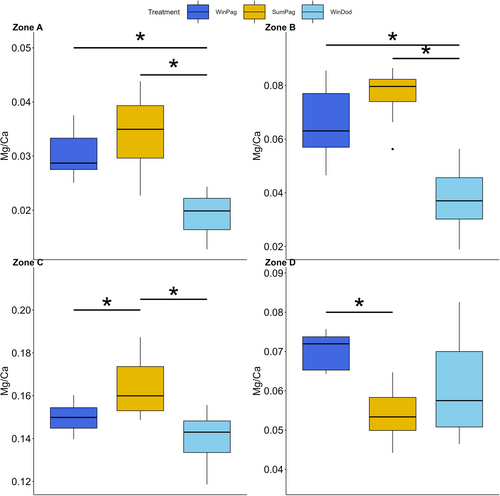
The Mg/Ca ratio of the tooth of P. lividus appeared to change between the regions for zones A (p < .001) and D (p = .003), while zone B (p < .001) presented variation among all treatments. Zone C showed no significant differences (Figure 6).
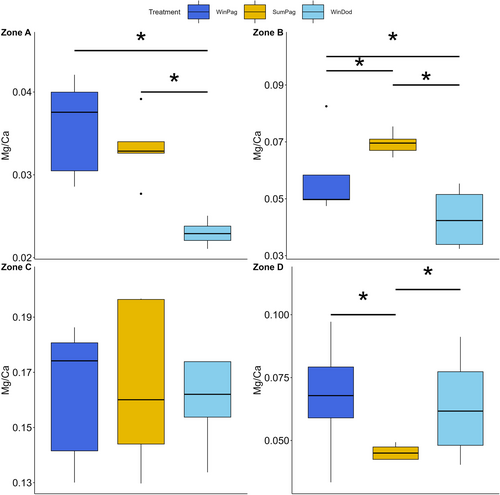
For S. granularis, zone C (p = .014) exhibited increased values in winter in Pagasitikos gulf compared to that in summer in the same region, whereas for zone A, a higher Mg/Ca ratio was observed in winter in Pagasitikos and it was the lowest in the same season in the Dodecanese region (p = .016) (Figure 7). Zones B and D showed no significant differences.
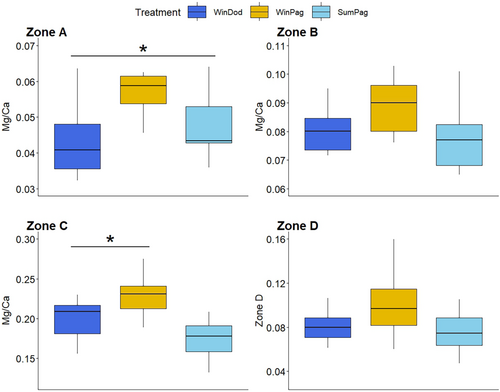
The Mg/Ca ratio of the tooth of D. setosum exhibited no significant differences with season or region except for zone A (p = .0002), where lower values were observed in winter in the Dodecanese region compared to the other treatments (Figure 8).
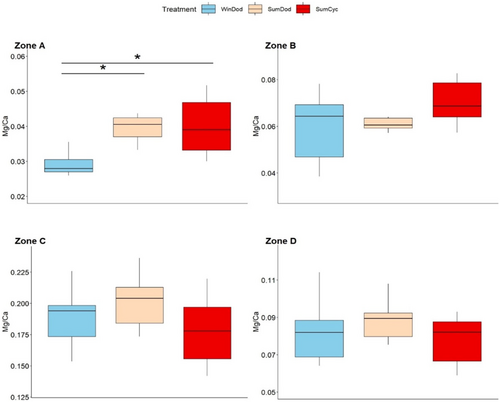
3.3 Multivariate analysis
The PCA analysis indicates that all examined echinoid species form seasonal clusters except for A. lixula, which is separated from the other three species (Figure 9). Zone C was the only Mg/Ca zone, which was not positively correlated with temperature. The elongation index was negatively correlated with the other morphometric indices. Regarding the abiotic factors, salinity and concentration of chlorophyll-a were negatively correlated with temperature. The three environmental variables showed a low contribution in PC1 and a high contribution in PC2.
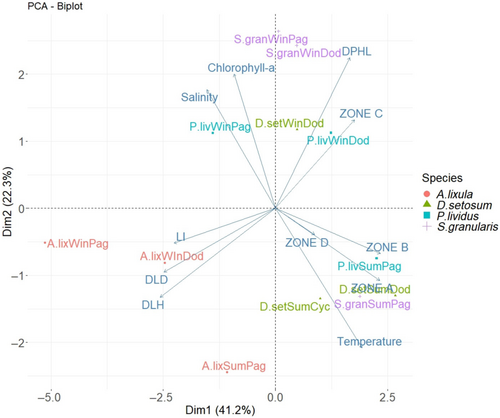
Using the Kaiser criterion, the optimal number of clusters to be used for hierarchical clustering on principal components (HCPC) was determined. The first two principal components were used both for the native species and all four species combined, explaining a cumulative variance of 71.4% and 66.9%, respectively. Based on the HCPC two dendrograms were obtained, facilitating the interpretation of the structure of data, both for the native echinoids and the combination of the four species. It is evident, both from the PCA and the HCPC dendrogram, that the three native species are separated from each other (Figure 10a,b). With the addition of D. setosum, it becomes evident that this species shares a wide area with the native ones, particularly S. granularis and P. lividus. The number of clusters remains constant (n = 3), while individuals of D. setosum are heavily clustered together with the specimen of S. granularis (Figure 10c,d). In both dendrograms individuals of A. lixula are clustered together and separated from the other two clusters.
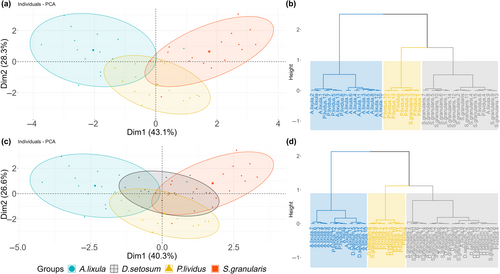
4 DISCUSSION
It was previously indicated that a functional relationship exists between trophic morphology and diet in regular echinoids (Hagen, 2008). Additionally, the Mg/Ca ratio is hypothesized to be related to increased hardness in the sea urchin tooth (Ma et al., 2007). Thus, a combination of morphological aspects of the Aristotle's lantern and demi-pyramids combined with the Mg/Ca content of the tooth might have an ecological significance, related to the exploitation of different food sources for different species. The existing literature describes A. lixula as an omnivore with a tendency to carnivory, and P. lividus as a herbivorous opportunistic generalist with a preference to soft algae, while S. granularis and D. setosum exhibit herbivory coupled with a tendency towards bioresion (Table 2). Resource allocation might also be affected by feeding preferences, food availability, and environmental conditions (e.g., Ebert, 1980; Ebert et al., 2014; Epherra et al., 2015). Regarding the intraspecific variation of the Mg/Ca ratio in the echinoid tooth the key factors include abiotic conditions, mainly temperature and salinity, as well as diet, although the existing literature is rather limited (Hermans et al., 2010; Kolbuk et al., 2019).
| Species | Feeding type | Main food sources | Area | References |
|---|---|---|---|---|
| A. lixula | H | Encrusting corralines | Adriatic Sea (Western Mediterranean) | Privitera et al. (2008) |
| O/C | Vegetal items (e.g., Cladophora, Lithophyllum)/Animal items e.g., (Polychaeta, Bryozoa) | NE Spain (Western Mediterranean) | Wangensteen et al. (2011) | |
| O/C | ↑ Lipase (U/mg protein) | Granada Spain (Western Mediterranean) | Trenzado et al. (2012) | |
| O/C | Vegetal items (e.g., Encrusting algae)/Animal items e.g., (Sipunculids) | Ustica Sicily (Western Mediterranean) | Agnetta et al. (2013) | |
| C | 71% of the guts consisted of Chthamalus spp. | São Sebastião (SE Brazil) | Cabral de Oliveira (1991) | |
| P. lividus | H | Posidonia meadows (leaves and epiflora) | Mediterranean | Verlaque (1981) |
| H | Erect fleshy algae | NE Spain (Western Mediterranean) | Privitera et al. (2008) | |
| O/OG | Posidonia oceanica, leaf epiphytes, rhizome algae | NE Spain (Western Mediterranean) | Prado et al. (2010) | |
| O/H | Mainly vegetal items (e.g., Dictyota, Jania)/Animal items e.g., (3%–5%) | NE Spain (Western Mediterranean) | Wangensteen et al. (2011) | |
| H | ↑ cellulase activity (preference for flesh algae) | Granada Spain (Western Mediterranean) | Trenzado et al. (2012) | |
| O/H | Erect fleshy algae | Ustica Sicily (Western Mediterranean) | Agnetta et al. (2013) | |
| S. granularis | H | On rocky shore (encrusting coralline red algae)/on Posidonia meadows (rhizomes and entire roots) | Mediterranean | Verlaque (1981) |
| H/B | Coralline red algae | Bay of Marseilles (Western Mediterranean) | Sartoretto and Francour (1997) | |
| H | ↑ amylase activity (Coralline red algae) | Miguel Island, Azores (N Atlantic) | Trenzado et al. (2012) | |
| H | Algae | Miguel Island, Azores (N Atlantic) | Hipolito et al. (2020) | |
| D. setosum | H/B | Coral sediment (48%–52%)/algae (28%) | Coast of Kenya (Indian Ocean) | McClanahan and Muthiga (1988) |
| H | Codium geppiorum, Hydroclathrus clathrus | Fiji (Pacific Ocean) | Coppard and Cambell (2007) | |
| B | Platygyra carnosus, Porites lutea | Hong Kong | Dumont et al. (2013) | |
| B/C | Scleractinian corals | Hong Kong | Qiu et al. (2014) |
- Abbreviations: B, bioeroder; C, carnivorous; C, corallivorous; H, herbivorous; OG, opportunistic generalist; O, omnivorous.
The intraspecific comparison of the spatio-temporal effect on the morphometric indices revealed different trends of variation for different species. A. lixula and P. lividus alter the size of their mouth appendages in relation to the size of the test, while S. granularis and D. setosum exhibit variation regarding the elongation index of the teeth. Food availability has long been hypothesized to affect the relative length of the demi-pyramid and Aristotle's lantern in some echinoid species (e.g., Black et al., 1982; Ebert, 1980; Ebert et al., 2014; except deVries et al., 2019). The results regarding P. lividus and A. lixula might reflect food scarcity for these species in winter in Pagasitikos gulf, which is also supported by another study (Petihakis et al., 2005) (Figure 4). On the other hand, for S. granularis and D. setosum a change in width/length of the tooth is observed. This variation follows a seasonal trend, possibly indicating a shift towards a different trophic source, e.g., from erect algae to crustose corraline algae, in order to cope with the seasonal changes in food availability.
Regarding the Mg/Ca content, intraspecific differences were found for all species, although in different zones (Figures 5-8). Notably, P. lividus and D. setosum did not alter the Mg/Ca ratio in zone C (stone part), the zone with the most prominent functional role (Markel & Gorny, 1973). Temperature is among the main factors affecting the Mg/Ca content of echinoid teeth (Hermans et al., 2010). A. lixula seems to be mainly affected by temperature, while the Mg/Ca content of S. granularis seems to follow a similar trend with the elongation index, exhibiting increased values in winter in Pagasitikos (Figure 4). Finally, D. setosum exhibits differences only for zone A, which might be related to the different morphology of its grooved teeth compared to the keeled ones (Ziegler et al., 2012). However, a key parameter, which was not examined in this study, is the growth of the tooth, which appears to be continuous, but might be related to the degree of the grind and wear mechanism among different species (Gorzelak et al., 2017; Märkel, 1970).
The multivariate analysis using morphometrics, mineralogical, and environmental data indicates that A. lixula is separated from all other species, while for P. lividus, S. granularis, and D. setosum a clear effect of temperature exists, leading to a clustering of treatments rather than species (Figure 9). The fact that A. lixula exhibits a different diet compared to the other examined species, might be related to the separation observed here, although no causal connection can be made from this study.
On the interspecific level, an inferred relationship between both morphometrics and Mg/Ca ratios and feeding habits seems to exist, as was stated in previous studies (e.g., Contreras & Castilla, 1987; Hagen, 2008; Lawrence & Jangoux, 2013). A. lixula shows a tendency to carnivory and is clearly separated from the three herbivores in the PCA and HCPC (Table 2, Figure 10). This species presents the most elongated teeth and longest demi-pyramids in relation to test diameter (Table 1). P. lividus is characterized as an omnivore generalist with a tendency to herbivory, which is depicted in the PCA results (Figure 10). Finally, D. setosum and S. granularis appear to have similar feeding preferences, feeding primarily on coralline algae (Table 2). Both species also exhibited similar intraspecific trends, changing their demi-pyramid elongation index, while also presenting the highest Mg/Ca ratios (Figure 4, Table 1). Higher Mg/Ca ratios might be a result of a Mg-rich diet, as previously shown (Kolbuk et al., 2019). The similarities between S. granularis and D. setosum are most prominent when observing the clusters produced by HCPC, where S. granularis shares the same cluster with D. setosum (Figure 10).
There is evidence that another representative of the genus Diadema, namely Diadema africanum, can restrict the distribution of S. granularis in the Canaries archipelago (Tuya et al., 2001, 2007). It was also found that D. africanum can have detrimental effects for the densities of S. granularis in Madeira archipelago (Lourenço et al., 2022). The results presented here indicate that D. setosum might share the same feeding habits with S. granularis in the Eastern Mediterranean Sea, either leading to competition or additional pressure on calcareous algae when these species cooccur.
5 CONCLUSION
This study integrates mineralogical and morphometric data to infer relationships between feeding habits and various tooth features at both taxonomic and population levels within the Eastern Mediterranean echinoid communities. Through the examination of the Mg/Ca ratio alongside morphological characteristics, insights are gained as to how the structure of the tooth is tailored to fulfill specific ecological roles. This approach has provided valuable insights into the ecological roles of each species and their responses to environmental factors. Moving forward, this multidisciplinary approach can serve as a model for future studies seeking to unravel complex ecological dynamics within marine ecosystems.
AUTHOR CONTRIBUTIONS
Dimitris Vafidis: Conceptualization (lead); formal analysis (supporting); project administration (lead); supervision (lead); visualization (lead); writing – original draft (lead); writing – review and editing (lead). Anastasios Varkoulis: Conceptualization (lead); data curation (lead); formal analysis (lead); methodology (lead); software (lead); visualization (lead); writing – original draft (lead); writing – review and editing (lead). Stefanos Zaoutsos: Data curation (supporting); methodology (equal). Konstantinos Voulgaris: Conceptualization (lead); methodology (lead); software (lead); visualization (lead); writing – original draft (lead); writing – review and editing (lead).
ACKNOWLEDGMENTS
The authors thank Thomas Mygdalias for his assistance during the laboratory procedures.
FUNDING INFORMATION
This research was not funded.
CONFLICT OF INTEREST STATEMENT
The authors declare no conflicts of interest.
Open Research
DATA AVAILABILITY STATEMENT
The data used for this manuscript are uploaded to Dryad: https://doi.org/10.5061/dryad.7m0cfxq0c.



